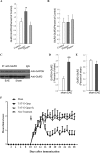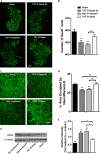Blocking GluR2-GAPDH ameliorates experimental autoimmune encephalomyelitis
- PMID: 25909084
- PMCID: PMC4402084
- DOI: 10.1002/acn3.182
Blocking GluR2-GAPDH ameliorates experimental autoimmune encephalomyelitis
Abstract
Objective: Multiple sclerosis (MS) is the most common disabling neurological disease of young adults. The pathophysiological mechanism of MS remains largely unknown and no cure is available. Current clinical treatments for MS modulate the immune system, with the rationale that autoimmunity is at the core of MS pathophysiology.
Methods: Experimental autoimmune encephalitis (EAE) was induced in mice with MOG35-55 and clinical scoring was performed to monitor signs of paralysis. EAE mice were injected intraperitoneally with TAT-fusion peptides daily from day 10 until day 30 after immunization, and their effects were measured at day 17 or day 30.
Results: We report a novel target for the development of MS therapy, which aimed at blocking glutamate-mediated neurotoxicity through targeting the interaction between the AMPA (2-amino-3-(3-hydroxy-5-methyl-isoxazol-4-yl) propanoic acid) receptor and an interacting protein. We found that protein complex composed of the GluR2 subunit of AMPA receptors and GAPDH (glyceraldehyde-3-phosphate dehydrogenase) was present at significantly higher levels in postmortem tissue from MS patients and in EAE mice, an animal model for MS. Next, we developed a peptide that specifically disrupts the GluR2 -GAPDH complex. This peptide greatly improves neurological function in EAE mice, reduces neuron death, rescues demyelination, increases oligodendrocyte survival, and reduces axonal damage in the spinal cords of EAE mice. More importantly, our peptide has no direct suppressive effect on naive T-cell responses or basal neurotransmission.
Interpretation: The GluR2 -GAPDH complex represents a novel therapeutic target for the development of medications for MS that work through a different mechanism than existing treatments.
Figures




Similar articles
-
Disruption of the GluR2/GAPDH complex protects against ischemia-induced neuronal damage.Neurobiol Dis. 2013 Jun;54:392-403. doi: 10.1016/j.nbd.2013.01.013. Epub 2013 Jan 27. Neurobiol Dis. 2013. PMID: 23360709
-
Disruption of GluR2/GAPDH Complex Interaction by TAT-GluR2NT1-3-2 Peptide Protects against Neuronal Death Induced by Epilepsy.Ann Clin Lab Sci. 2018 Jul;48(4):460-468. Ann Clin Lab Sci. 2018. PMID: 30143487
-
Diosgenin ameliorates cellular and molecular changes in multiple sclerosis in C57BL/6 mice.Mult Scler Relat Disord. 2021 Oct;55:103211. doi: 10.1016/j.msard.2021.103211. Epub 2021 Aug 10. Mult Scler Relat Disord. 2021. PMID: 34425463
-
Oral Tolerance Induction in Experimental Autoimmune Encephalomyelitis with Candida utilis Expressing the Immunogenic MOG35-55 Peptide.PLoS One. 2016 May 9;11(5):e0155082. doi: 10.1371/journal.pone.0155082. eCollection 2016. PLoS One. 2016. PMID: 27159446 Free PMC article.
-
Glutamate, T cells and multiple sclerosis.J Neural Transm (Vienna). 2017 Jul;124(7):775-798. doi: 10.1007/s00702-016-1661-z. Epub 2017 Feb 24. J Neural Transm (Vienna). 2017. PMID: 28236206 Review.
Cited by
-
Specific Alterations in Astrocyte Properties via the GluA2-GAPDH Complex Associated with Multiple Sclerosis.Sci Rep. 2018 Aug 27;8(1):12856. doi: 10.1038/s41598-018-31318-4. Sci Rep. 2018. PMID: 30150703 Free PMC article.
-
Absence of system xc- on immune cells invading the central nervous system alleviates experimental autoimmune encephalitis.J Neuroinflammation. 2017 Jan 13;14(1):9. doi: 10.1186/s12974-016-0787-0. J Neuroinflammation. 2017. PMID: 28086920 Free PMC article.
-
A Narrative Review on Axonal Neuroprotection in Multiple Sclerosis.Neurol Ther. 2022 Sep;11(3):981-1042. doi: 10.1007/s40120-022-00363-7. Epub 2022 May 24. Neurol Ther. 2022. PMID: 35610531 Free PMC article. Review.
-
Synaptopathy connects inflammation and neurodegeneration in multiple sclerosis.Nat Rev Neurol. 2015 Dec;11(12):711-24. doi: 10.1038/nrneurol.2015.222. Epub 2015 Nov 20. Nat Rev Neurol. 2015. PMID: 26585978 Review.
-
EF1α-associated protein complexes affect dendritic spine plasticity by regulating microglial phagocytosis in Fmr1 knock-out mice.Mol Psychiatry. 2024 Apr;29(4):1099-1113. doi: 10.1038/s41380-023-02396-2. Epub 2024 Jan 11. Mol Psychiatry. 2024. PMID: 38212373
References
-
- Trapp BD, Stys PK. Virtual hypoxia and chronic necrosis of demyelinated axons in multiple sclerosis. Lancet Neurol. 2009;8:280–291. - PubMed
-
- Compston A, Coles A. Multiple sclerosis. Lancet. 2008;372:1502–1517. - PubMed
-
- Kieseier BC, Wiendl H, Hemmer B, Hartung HP. Treatment and treatment trials in multiple sclerosis. Curr Opin Neurol. 2007;20:286–293. - PubMed
-
- Trapp BD, Nave KA. Multiple sclerosis: an immune or neurodegenerative disorder? Annu Rev Neurosci. 2008;31:247–269. - PubMed
-
- Stys PK, Zamponi GW, van Minnen J, Geurts JJ. Will the real multiple sclerosis please stand up? Nat Rev Neurosci. 2012;13:507–514. - PubMed
LinkOut - more resources
Full Text Sources
Other Literature Sources
Molecular Biology Databases
Research Materials

